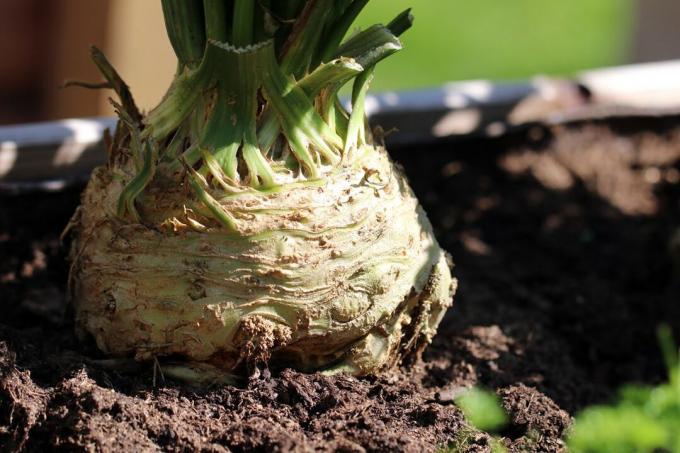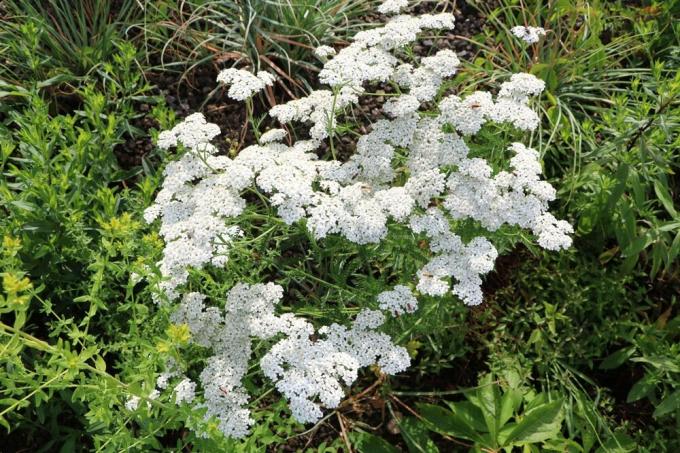

Table of contents
- Characteristics
- variants
- Location
- Floor
- sowing / planting
- Care
- watering & fertilizing
- Harvest & Storage
- sorts
- Diseases
- pests
- mixed culture
- seed collection
Celery isn't just a popular soup vegetable. He's healthy too. It is even healthier to grow the vegetables yourself. Find out how here.
Characteristics
- Origin: Europe, America, Asia and Africa
- Plant Family: Umbelliferae
- Type of vegetables: stem vegetables, tuber vegetables
- Variants: celeriac, celery sticks, celery root
- Growth: herbaceous plant
- Nutrient requirements: heavy feeder
- Flower: umbels
- Propagation: seeds
- Use: Soup or sauce seasoning, vegetables
- Special features: the aromatic smell is typical, celery can trigger severe allergies
variants
celery root(Apium graveolens var. rapaceum)
This celery has a thick bulb that can weigh up to a kilo. It is mainly used as a soup vegetable. In addition, slices of the tuber can be fried as celery shavings.
celery(Apium graveolens var. dulce)
In the case of celery or celery, the leaf stalks are used. Once long enough, they can be used fresh or cooked, singly or in batches.
celery(Apium graveolens var. secalinum)
The celery (also cut or leaf celery) is used exclusively as a spice. Together with salt, for example as celery salt. Only the leaves are used for this.
Location
All celery varieties like a warm, sunny, somewhat sheltered location. The location should be breezy but not windy. The quicker the plants can dry off after rain, the less fungal diseases they have to contend with.

Floor
Because they are heavy feeders, they grow better on heavy than light soils. Humic, loamy soils that are improved with compost are good. In sandy soil, the stalks or tubers remain smaller, which is why sandy soil should be stimulated to form humus by adding more compost.
sowing / planting
- When: mid to late March
- Sowing: prefer under glass
- Sow the celery directly
- only cover thinly with soil (light germinators)
- Planting: mid to late May
- Space requirement: at least 40×40 cm
- Do not cover celeriac bulbs with soil when planting
A notice:
If it is too cold when planting out, the celery tends to flower.
Care
Chop and mulch regularly between the celery plants to prevent weed growth and reduce evaporation. However, they are flat-rooted, so care must be taken when chopping.
Specialty celery
For celery, the stalks of the celery have to be bleached, for this the earth around the plant is mounded up. Another variation is to tie the stems together and cover them with thick, dark paper or cardboard. Bleaching makes the taste milder. Growing auto-bleaching strains saves extra work.
watering & fertilizing
Celery needs a lot of water to form large bulbs and fleshy stalks. It needs to be thoroughly watered on a regular basis. In case of drought, additional water is given.
Fertilize celeriac in particular once or twice. Use compost or other organic material for this. Horn meal or horn shavings are well suited. Mulching also contributes to continuous fertilization.
Harvest & Storage
celery root
Harvest begins in October as soon as the outer leaves turn yellow. Take the tubers out of the ground, use them directly or store them. To do this, cut back the outer leaves and pound the tuber in damp sand in a cool place. Celeriac tolerates light frost.
celery stalk
The harvest takes place continuously from around July until the first frosts, after which the stalks are no longer edible. The plant forms new stems when the outer ones are removed. Pickled celery is harvested whole by cutting off the plant just above the ground. Celery can be eaten raw. It is also suitable for cooking and steaming. Wrap the sticks in a damp kitchen towel and keep them fresh for a few days. They should be stored in the fridge.
celery
The herb is very versatile. Harvest as soon as the leaves are large enough. They can be used raw, dried or cooked. They are also suitable for longer storage.

A notice:
Celeriac and celeriac are also suitable for freezing.
sorts
Celery root:
- 'Monarch' (large, well storable tuber)
- 'Ibis' (white meat, bolt proof)
- 'Prince' (easy-care, robust)
celery stalk:
- 'Darklet' (early, sow in February, harvest from July)
- 'Tall Utah' (high yield, mild flavor)
- 'Spartacus' (especially long stems)
- 'Golden Spartan' (yellow-green, fast-growing)
- 'Pascal' (self-bleaching)
Diseases
leaf spot disease
This disease is caused by fungi and is recognizable by yellowish spots on the leaves. It is treated with appropriate pesticides. It is better to prevent this by keeping the plants as dry as possible and getting an airy location.
celery scab
Cracked spots form on the celery bulbs, through which rot fungi can penetrate in the warehouse. The celery is therefore less durable. Once the disease has broken out, it cannot be fought. Therefore, make sure not to plant young plants until the soil has warmed up sufficiently. Also pay attention to the crop rotation and observe a planting break of several years.
pests
aphids
Aphids like to settle in the narrow spaces between the celery stalks in order to suck plant juices. As long as there are only a few animals, beneficial insects take care of the pests. A mild soapy solution, with which the plants are rinsed, helps with many lice.
snails
Snails are a problem, especially for young plants. These are protected by so-called snail collars for individual plants or the bed is bordered with a snail fence.

celery fly
Similar to the carrot or onion fly, this insect is attracted by the smell of the plants and lays its eggs on the stems. The larvae eat passages into the interior of the plant and sometimes make it inedible. In addition, the tubers can remain significantly smaller or stunted. The most effective against vegetable flies of all kinds are dense plant protection nets that are spread over the crop. They must have good ground contact so that flies cannot get in at any point.
nematodes
The tiny nematodes, invisible to the naked eye, are a soil problem. They can infest many types of vegetables and damage growth. Fighting roundworms is extremely difficult. On the one hand, all infested plants must be disposed of, on the other hand, it helps in stubborn cases only to leave the area permanently fallow, which means that there are no weeds there either grow. The nematodes are thus starved for months.
A notice:
Growing certain plants like marigolds has a soil-improving effect and can repel nematodes.
voles
Voles also cause a lot of damage in the vegetable garden. They like to eat tuber vegetables, including celeriac. Preventing them is very difficult. One option is to completely encase the beds with deeply buried chicken wire. Although ultrasonic devices promise a remedy, they do not work particularly well. Hiding places for larger beneficials such as weasels are more helpful. Perches for birds of prey can also help. There are special traps for the passages of the voles.
mixed culture
Vegetable types in mixed cultures support each other, for example they drive away certain pests with their smells. Celery is suitable for mixed cultivation with cabbage, fruit vegetables and leeks. Celery goes well with garlic in the herb bed. Parsley, potatoes or corn are less suitable.
A notice:
Since celery is an umbelliferae, all variants of the plant should not be grown after other umbelliferae. These include carrots and fennel.
seed collection
Of course, you can buy celery seeds everywhere. However, growing your own seeds has advantages. Only seed-resistant varieties are suitable for this, i.e. no hybrid breeds. Celery blooms if planted too cold. For seed production, this means that some plants are planted in early May or late April. The umbels mature on the plant but are cut before the seeds fall. In a dry place, the seeds will continue to ripen for a while. If they are completely dry, they can be shaken out of the umbels. The seeds will keep in a tightly closed container at least until the next sowing.
 garden editorial
garden editorial I write about everything that interests me in my garden.
Learn more about medicinal herbs

What is the effect of yarrow? | 9 areas of application
Yarrow is considered by many to be a weed in the garden, but in herbal medicine positive effects on health are attributed to the plant. But what effect should yarrow have and how can the plant be used?

Gotu Kola, Centella asiatica: Care from A – Z
The plant Centella asiatica, also known as Indian pennyroyal or tiger grass, is considered a so-called superfood and is currently very trendy. In Asia it is used under the name Gotu Kola as a medicinal plant that is said to accelerate wound healing and have an antidepressant effect. The tiger grass requires relatively little care and can basically also be grown successfully in this country.

Make comfrey ointment yourself | Instructions for making leaves
Comfrey is a valuable herb whose healing properties were praised by Paracelsus and Hildegard von Bingen. It can be used to make oils, tinctures and ointments. Both the roots and the leaves are suitable for making an ointment.

Process Comfrey | Dry and apply comfrey root
Comfrey, also known as comfrey or comfrey, is a very old medicinal plant that grows in the garden and outdoors in this country. However, the use of comfrey should always be done with care, because the plant also contains harmful substances.

Identify edible wild herbs: list of 20 herbs
Wild herbs can be found everywhere in nature. We don't have to sow them first. No tedious maintenance either. Just harvest and enjoy. Sometimes it's the leaves, sometimes the blossoms or even the roots that give our dishes a special pep.

Brahmi plant, Bacopa monnieri, bacopa - care from A-Z
Known from Indian medicine (Ayurveda), the bacopa is still an insider tip among indoor plants. Known as an aquarium plant for a long time, Brahmi can be found more and more often on the windowsill of Germans and is considered a particularly easy-care plant due to its undemanding nature.



